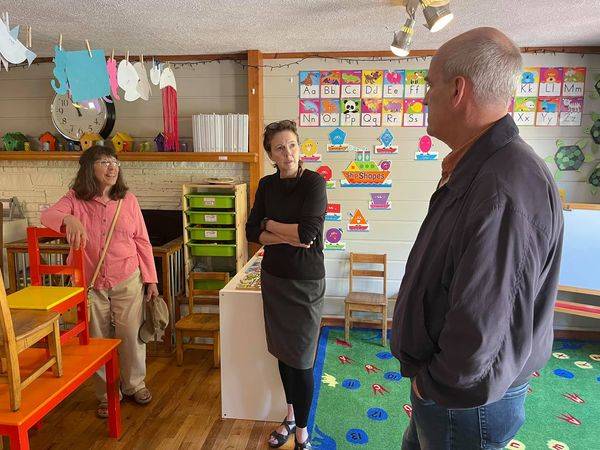The island has long struggled with a childcare shortage — coming out of the pandemic has made it all the more apparent.
The Joyce L. Sobel Family Resource Center has provided an array of family and early childhood support programs and basic social services for 25 years. During non-COVID times they offered drop-in playgroups. They also help families that need support with housing, finding employment, and childcare.
Resource center Executive Director Jennifer Armstrong is very aware of the lack of childcare on the island. One thing that the family resource center can’t do is provide child care directly, which is hard when working so closely to the issue, according to Armstrong.
“Last fall, because they were seeing a significant number of childcare providers close their business, they were on the front lines of seeing people impacted by COVID regain their financial stability,” said Armstrong.
Armstrong continued to say that seeing all these places close down made them even more aware of what had already been a prevalent issue to begin with. The resource center received a grant from the Washington State Department of Commerce to conduct an islandwide child care needs assessment.
The center built a strong community advisory panel by identifying the main stakeholders in this issue. The panel ranges from childcare center directors to the representatives of the economic development council and community foundation.
At that time, they were looking at families with children ages 0 to 6. Following that grant, the center received some local help from the San Juan Island Community Foundation that contributed extra grant money to expand the needs assessment to also look at childcare for kids up to age 12.
The project consisted of doing five different surveys, collecting data, and conducting interviews with most of the childcare providers. This report was finished last week and it will be released to the general public sometime in August, Armstrong said.
Economic Development Council Executive Director Victoria Compton elaborated on how complex the issue really is. Looking at the issue from an equity standpoint, she said, “There is a great wad of data and other information that shows that if childcare isn’t under control it can’t grow the economy.” Due to this, she describes childcare as an investment for the economy.
What is even more of an issue is safety. Armstrong explained that if there aren’t many viable options for childcare, parents may resort to not-so-good options if they feel that is what they have to do. She added that it is especially rough on the island because many childcare facilities close for the summer, but as a tourist town, many people work in the service industry and are the busiest in the summer.
“So many of their young families here are working in service jobs related to tourism and hospitality and one thing their assessment definitely confirmed is that as a community they aren’t providing childcare needs in terms of the hours of operations,” Compton added. “Some of the most terrible child abuse comes from children being left with untrustworthy people.”
What makes childcare even more difficult on the island, is that it is hard to make a good living in childcare nationwide, but budgets on the island tend to be tighter due to a higher cost of living, according to Compton.
Rep. Rick Larsen said that due to the American Rescue Plan, there is a childcare tax credit. It covers about 133,000 children. Last week, a spending bill for childcare and block grants was passed. It was funded one-and-a-half million above last year’s level. Tax credit money goes directly into family bank accounts and can be spent on anything from childcare to groceries.
“There’s really some special unique child care challenges in the San Juan Islands,” Larsen said.
Recognizing these unique hurdles, Larsen aims to be physically present on the island while discussing issues with the locals. He said he allows them to come up with most of the solutions while he works with congress to try and fund those ideas.
“We need to create more sustainable positions that pay a living wage,” Compton said. “This reflects what the community needs.”



